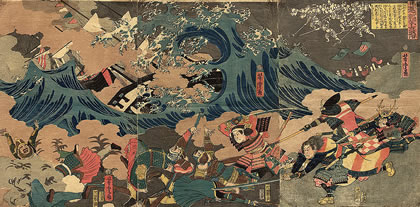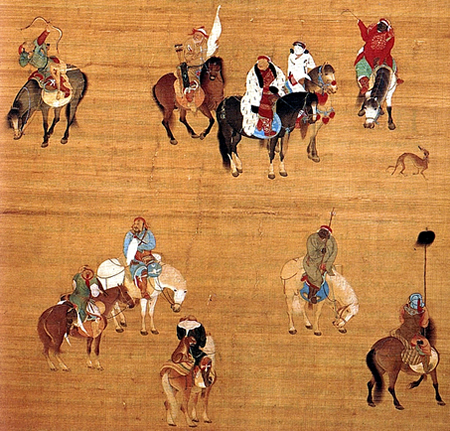 |
| Hulagu Khan with his wife |
In 1251
Mongke Khan, a grandson of
Genghis Khan, became the grand khan of the Mongols and convened his three brothers and close relatives in a meeting to divide the vast territories that had been conquered. To his brother
Kubilai Khan, who would eventually play host to
Marco Polo, he gave southern China.
Mongke gave northern
Persia to his brother Hulagu, with instructions that the area from Persia to Egypt should be subjugated to Mongol rule. Although Mongke was the supreme leader of the Mongols, he parceled out regional control to others, who would rule as lesser khans or il-khans with their states being known as il-khanates or lesser khanates.
Hulagu set off with an army of at least 100,000 troops in early January 1256, heading first for the mountain fortresses of
Ismaili Shi’i Muslim sect that had terrorized other Muslim rulers for over a century.
After besieging the Assassins’ fortresses of Mazanderan, Meimundiz, and Alamut, the Mongols captured the sect’s leader, Rukn ad-Din Kurshah, who was later murdered. By late December the last Assassin fortress of Alamut surrendered to Hulagu. Hulagu then turned his attention to Iraq. He sent a message to the Abbasid caliph al-Mustasim that demanded his acceptance of Mongol supremacy.
Hulagu was enraged when the caliph, the symbolic head of Sunni Islam, refused. Mongol forces headed toward Iraq, receiving support from some of the Abbasid Caliphate’s Shi’i Muslim subjects, who had been angered by disrespect shown toward their community by al-Mustasim. Cities with substantial Shi’i populations, such as Mosul, Najaf, and Karbala, surrendered without a fight and were spared by the Mongols as a result.
By November, segments of Hulagu’s army had begun arriving outside the Abbasid capital city of Baghdad and on January 17, 1258, his entire army had arrived. That same day the small Abbasid army was destroyed in battle outside of the city and the siege of Baghdad commenced. Within two weeks the Mongols had overrun sections of the city’s defenses after battering down the walls with massive siege engines.
On February 10 after Hulagu had refused to negotiate a peaceful handover of the city al-Mustasim came out of Baghdad and surrendered. Ten days later, the caliph was executed by being rolled up in a carpet and trampled to death. The Mongols were superstitious and wary of shedding the blood of a monarch.
Baghdad, which had stood for six centuries, was sacked, with many of its architectural marvels, including the caliph’s palace and the grand congregational mosque, burned to the ground. The city’s libraries, which were filled with thousands of scholarly manuscripts on subjects ranging from the sciences to literature and philosophy, were also destroyed and their holdings were either burned or tossed into the
Tigris River.
The majority of Baghdad’s citizens were massacred, with most sources placing the number of deaths between 90,000 and 250,000. Hulagu spared the city’s Christians and Shi’i Muslims. He reportedly was sympathetic to the former group, possibly because both his mother and his favorite wife were Nestorians, members of an eastern Christian sect considered heretical by the Roman and Byzantine churches.
As news of the fall of Baghdad and the slaughter that followed spread throughout the Middle East, many neighboring Muslim states surrendered without resistance to Hulagu, hoping to avoid the fate of al-Mustasim. The Mongols’ next target was Syria, which was ruled by the waning Ayyubid dynasty, which had been founded in the late 12th century by the Kurdish Iraqi
Sultan Saladin (Salah ad Din, Yusuf).
Although the Ayyubid sultan An-Nasir Yusuf had submitted to Mongol authority, Hulagu still entered Syria with his army. He first defeated al-Kamil Muhammad, a young Ayyubid commander, whose city was captured and who was then tortured to death.
On August 11, 1259, Mongke died while campaigning against the Southern Song (Sung) in China. A succession crisis in the Mongol east pitted Kubilai against his brother Arik Boke, the ruler of Mongolia. Although Hulagu did not claim the position of grand khan for himself, he supported Kubilai. Thereupon he set out for China with the bulk of his troops, leaving a small garrison in the Middle East. In return Kubilai confirmed Hulagu as the il-khan, ruling over Persia and the Middle East.
A greater threat to Hulagu was his cousin Berke, the Khan Kipchak, who some sources claim converted to Islam or, at the very least, was heavily sympathetic to the religion and was angered at Hulagu’s destruction of Baghdad. Fearing an invasion by Berke, Hulagu withdrew back into Persia with the bulk of his army. In Syria, he left behind between 10,000 and 20,000 troops under the command of Naiman Kitbuqa, his best general and a Nestorian Christian.
After negotiating an alliance with the remaining European crusader states along Syria’s Mediterranean coast, Kitbuqa then proceeded to besiege or capture other Syrian cities, including Aleppo, which fell on February 25, 1260.
The northern Syrian cities of Hama and Homs surrendered to Hulagu soon thereafter, as did Damascus after Sultan an-Nasir had fled toward Egypt. By early April the last vestiges of Ayyubid resistance in Syria had been crushed and the Mongols proceeded to conquer much of Ayyubid Palestine in the following months.
The inexorable wave of Mongol expansion, however, began to wane soon after Kitbuqa’s conquests in Palestine. Later in 1260 his alliance with the
crusader states ended after European nobles from the city of Sidon attacked a Mongol scouting party. Kitbuqa responded by besieging and then sacking that city.
When news of this rift reached Cairo, the capital city of the
Mamluk Turks, their sultan, Qutuz, sent one of his generals, Baybars, to Palestine with a large army. On September 3, the Mamluk army, which was made up of professional and highly trained troops, unlike that of their adversaries, defeated Kitbuqa’s smaller force.
The Mongol general was captured and executed. The Mamluks recaptured Palestine and Syria and repulsed a Mongol invasion force in December. Hulagu’s dreams of a Middle Eastern empire that reached Egypt were dashed, though he was able to solidify his control over Persia before his death in February 1265.
The dynastic line he founded, the Il-Khanids, would remain in power over Persia and parts of Central Asia until 1335. Within a few generations after Hulagu’s death, his successors converted to Islam and became some of history’s greatest patrons of Islamic art, architecture, and literature.







